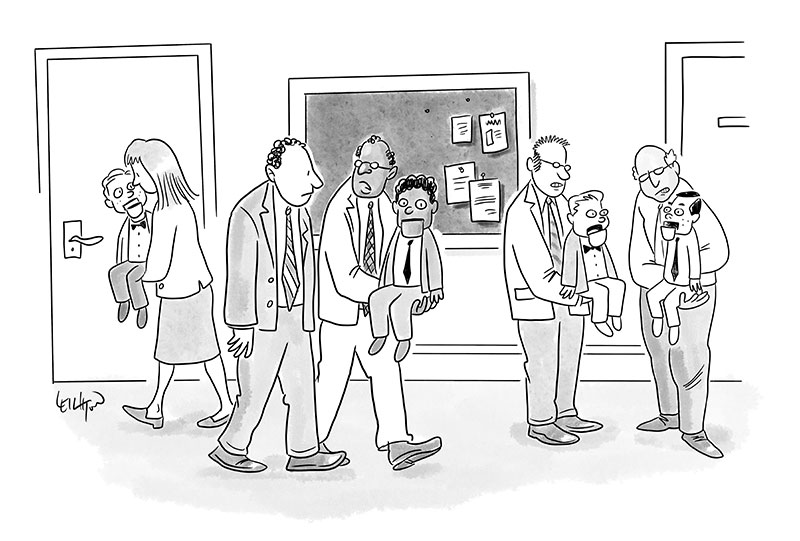 Robert Leighton’s cartoon is set in an office, where all but one of the employees is carrying his or her own ventriloquist’s dummy. One of these employees is saying something to a co-worker who does not have a dummy.
Robert Leighton’s cartoon is set in an office, where all but one of the employees is carrying his or her own ventriloquist’s dummy. One of these employees is saying something to a co-worker who does not have a dummy.
I first thought about ventriloquists who use their dummies to make insulting or vulgar comments, a practice that could backfire in an office setting: “He calls the boss a jackass, and I get fired.”
Then I thought of an employment-related pun: “We’ve been told to get rid of the dead wood.”
Finally, I came up with a pandemic joke based on the idea that it’s easier to practice ventriloquism when no one can see your lips move: “I miss masks.”
Now let’s see how you did.
I’m going to begin with three entries that were remarkably similar to my three captions:
- “I can’t believe what yours said to the CEO!”
- “Boss, could you clarify who you meant by deadwood?”
- “This was way easier with masks.”
That first entry is superior to mine because it explains why the one employee has no dummy.
Any cartoon that features ventriloquists will elicit a lot of captions featuring the word dummy. Most will be bad, but I thought these were pretty good:
- “You’d better dummy up.”
- “Dummy up.”
- “We’re a dummy corp.”
- “They didn’t tell you this is a dummy company?”
- “We don’t use the D-word here.”
The fact that the employee who’s speaking is African-American lends that last caption a certain resonance it otherwise might not have.
Here are the week’s best puns that don’t rely on the word “dummy:”
- “You’ll need to stop by non-human resources.”
- “You could stand to build a little character yourself.”
- “Talk to the hand puppet.”
- “I say it’s Charlie McCarthyism.”
- “When are they going to make you a partner?”
The following three captions take common expressions and give them different meanings in the contest of the drawing:
- “I can’t understand a word he says.”
- “It gives us the illusion of control.”
- “Remember, you didn’t hear that from me.”
- “What’s the matter? Don’t you have anyone to speak for you?”
That last caption would work better without the first three words.
Here’s an old joke: “How can you tell when a lawyer is lying? His lips move.” And this entry is a variation on that joke: “How can you tell when a lawyer is a bad ventriloquist?”
This next entry suggests that the man without a dummy is a new employee who’s going through orientation: “We start you out with a sock puppet.”
And this entry connects ventriloquists to the office setting by alluding to the cases that are used to transport dummies: “Well what did you think was in our briefcases all this time?”
Here’s a bizarre explanation for all the dummies, and it suggests that the cartoon is set not in an office but in a university: “The science department lost a bet with the theatre department.”
And here’s a terrific reference to a traditional ventriloquist trick: “Now watch as he gives an earnings report while I drink from the watercooler.”
This entry does not even try to explain why everyone is carrying a dummy—“I wouldn’t ask your help, but you’re the only one with both hands free”—but that’s one of the reasons I like it.
Before announcing the winner of this week’s contest—and it’s an entry I have not yet highlighted—I want to examine one aspect of Leighton’s cartoon that no one, myself included, addressed. The employee who’s speaking appears to be talking out of the side of his mouth like an amateur ventriloquist who’s speaking through his dummy. (That also appears to be the case with the employees in the background. Look closely at their mouths.) Nevertheless, in all of my captions, and in all of the entries I highlighted, the employee who’s talking is speaking for himself. He’s not throwing his voice. I, therefore, apologize to Leighton if we all missed a key part of his drawing.
Now, on to this week’s winner—the one entry that actually made me laugh out loud: “Most of us are retired proctologists.”
ENTER THIS WEEK’S CAPTION CONTEST
Lawrence Wood has won The New Yorker’s Cartoon Caption Contest a record-setting seven times and been a finalist two other times. He has collaborated with New Yorker cartoonists Peter Kuper, Lila Ash, Felipe Galindo Gomez, and Harry Bliss (until Bliss tossed him aside, as anyone would, to collaborate with Steve Martin). Nine of his collaborations have appeared in The New Yorker, and one is included in the New Yorker Encyclopedia of Cartoons.

